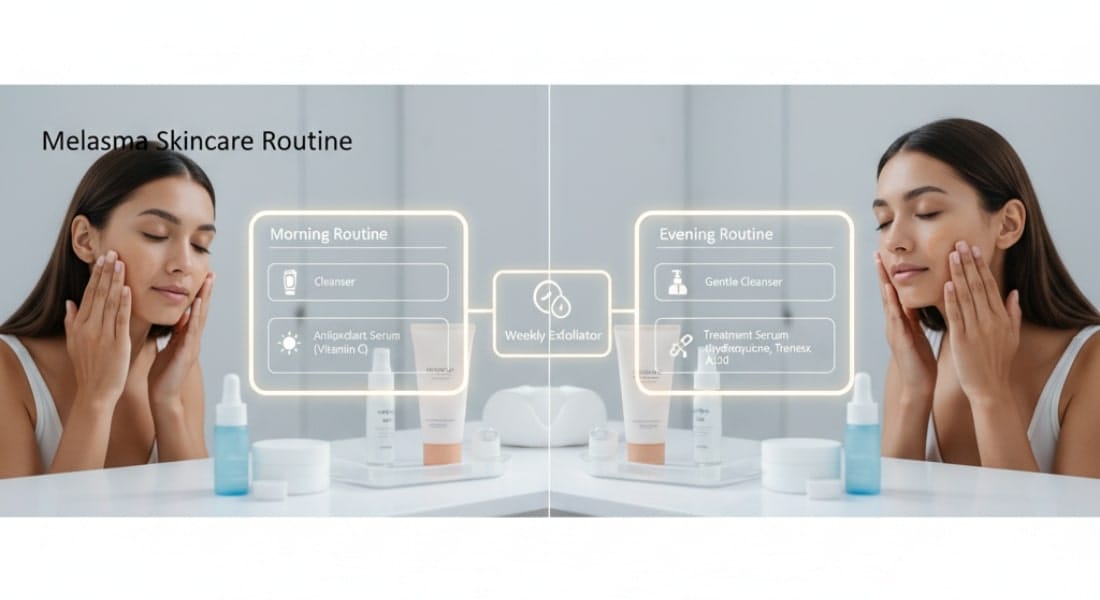Melasma is a common but often misunderstood skin condition that can significantly impact a person’s self-confidence. Known for creating symmetrical, discoloured patches on the face, melasma can feel like an unending challenge. If you’ve ever looked in the mirror and wondered, “What is melasma?”, you’re not alone. This guide is designed to provide you with a comprehensive, medically accurate understanding of this condition and, most importantly, explore effective, evidence-based solutions you can use for melasma treatment at home. We’ll break down its causes, common triggers, and a step-by-step melasma skincare routine that includes specialized, medical-grade products like the MELINE range, designed to give you back control over your complexion.
What is Melasma?
Melasma is a chronic skin condition characterized by hyperpigmentation—the overproduction of melanin, the pigment responsible for skin color. It typically presents as light brown, dark brown, or grayish patches on the skin. The condition is non-contagious and not medically harmful, but its visible nature can cause significant emotional distress and anxiety.
While melasma can affect anyone, its prevalence is notably higher among women and individuals with ethnic skin tones (Fitzpatrick skin types III-VI), who have a higher concentration of active melanocytes. According to the American Academy of Dermatology, approximately 6 million people in the United States have melasma, with 90% of those affected being women. Furthermore, research indicates that between 15% and 50% of pregnant women experience melasma, earning it the nickname “the mask of pregnancy.” While less common, men can also develop the condition, accounting for about 10% of reported cases. Understanding “What is melasma and what causes it?” is the first step toward effective management. The condition is often triggered by a combination of factors, including sun exposure, hormonal fluctuations, and genetic predisposition.
Common Signs and Symptoms
Recognizing the signs of melasma is key to an early and effective treatment strategy. The most common symptom is the appearance of hyperpigmented patches, which are often symmetrical on the face.
- Symmetrical Patches: Melasma’s hallmark is its characteristic bilateral, or mirror-image, pattern. Patches typically appear on both sides of the face in a symmetrical fashion. This symmetry helps differentiate it from other forms of hyperpigmentation like post-inflammatory hyperpigmentation (PIH).
- “Mask-like” appearance: The patches can form a distinct pattern that covers the cheeks, nose bridge, forehead, and upper lip, sometimes creating a “mask-like” appearance. Other common areas include the chin and jawline.
- Uneven Pigmentation: The colour of the patches can range from light tan to dark brown or even blue-grey, depending on the depth of the melanin in the skin layers. Epidermal melasma (pigment in the top layer) appears darker and responds better to topical treatments, while dermal melasma (pigment in the deeper layer) appears blue-grey and is more challenging to treat. A dermatologist can help determine the type, which influences the best course of treatment.
Causes and Risk Factors
Understanding the underlying causes is crucial for preventing and managing melasma flare-ups. The condition is not caused by a single factor but is often a result of several triggers working in combination.

- Hormonal Changes: This is a primary cause, which is why melasma is so common during pregnancy. Hormonal shifts from pregnancy, birth control pills, hormone replacement therapy, and even underlying conditions like thyroid issues can stimulate melanocyte activity, leading to increased melanin production.
- UV Radiation and Blue Light: Sun exposure is arguably the most significant trigger. UV radiation from the sun’s UVA and UVB rays, and even the high-energy visible (HEV) light or “blue light” emitted from electronic screens (smartphones, computers), can stimulate melanin production. Just a few minutes of unprotected sun exposure can undo months of treatment and darken existing patches.
- Genetic Predisposition: A family history of melasma significantly increases your risk of developing the condition. It’s estimated that up to 50% of people with melasma have a family member who also has it.
- Lifestyle Factors: Chronic stress and inadequate sleep can impact hormonal balance, while excessive heat exposure (e.g., from cooking, saunas) can also be a trigger for some individuals. Certain photosensitizing medications can also make the skin more susceptible to hyperpigmentation.
Can Melasma Be Treated at Home?
While melasma can feel stubborn and frustrating, the good news is that it is highly manageable, and yes, effective melasma treatment at home is possible. However, it’s important to manage expectations and understand the difference between ineffective home remedies and clinically-proven, professional-grade products.
Most over-the-counter (OTC) creams found at drugstores and DIY natural remedies (like lemon juice or vinegar) are not potent enough to make a significant difference. In some cases, these can even cause irritation, leading to post-inflammatory hyperpigmentation (PIH) and making the situation worse. The key to successfully treat melasma without a dermatologist for mild to moderate cases lies in a consistent, evidence-based melasma skincare routine that combines robust sun protection with medical-grade topical treatments. These products contain higher concentrations of active ingredients designed to target melanin production at a cellular level, delivering far superior results compared to standard retail options. Aakaar Medical Technologies Ltd specializes in such professional-grade solutions, empowering you to effectively manage your melasma from the comfort of your own home.
At-Home Treatment Options for Melasma
A successful at-home regimen for melasma is a multi-step process that requires consistency and the right products. The goal is to inhibit melanin production, reduce existing pigmentation, and prevent future discolouration.

Daily Skincare Routine for Melasma
Step 1: Gentle Cleansing Start your day and end your night with a gentle, non-irritating cleanser. Avoid harsh, abrasive products that can trigger inflammation and worsen pigmentation.
Step 2: Daytime Protection with MELINE Sun protection is the most critical step in any melasma skincare routine. Even a few minutes of sun exposure can undo months of treatment. After cleansing, apply a broad-spectrum sunscreen with an SPF of 30 or higher.
- MELINE 02 Ethnic Skin Day: This product is a crucial component for melasma treatment at home, designed specifically to protect and treat melasma in ethnic skin types. It is a powerful day cream formulated to combat UV-induced hyperpigmentation while providing anti-aging benefits. Its unique blend of ingredients works throughout the day to inhibit tyrosinase (the key enzyme responsible for melanin production), reduce existing spots, and provide antioxidant protection against environmental damage. To start your journey to a more even skin tone, explore the benefits of MELINE 02 Ethnic Skin Day.
Step 3: Targeted Night-Time Repair with MELINE While daytime focuses on protection, nighttime is for repair and regeneration. This is when your skin’s cells work to correct the damage from the day.
- MELINE 02 Ethnic Skin Night: This is your secret weapon for an effective melasma treatment at home. This potent night cream is formulated to work intensively while you sleep. It contains a synergistic blend of active ingredients that target and break down excess melanin, reduce the size and intensity of melasma spots, and improve overall skin texture. The formula is specifically designed to work for ethnic skin tones, which are more susceptible to hyperpigmentation. To support your skin’s repair process and diminish stubborn pigmentation, learn more about MELINE 02 Ethnic Skin Night.
Step 4: Sun Protection is Non-Negotiable This step bears repeating. Even with the best skincare products for melasma, without consistent sun protection, your efforts will be in vain. Wear a wide-brimmed hat and sunglasses, and seek shade during peak sun hours (10 a.m. to 4 p.m.). Reapply sunscreen every two hours, especially if you are outdoors or if you are sweating.
The Role of Medical-Grade Products vs. Natural Remedies
While many people search for “how to reduce melasma naturally,” it’s crucial to understand the limitations of such methods. While ingredients like aloe vera, green tea extract, and licorice root have antioxidant properties, they lack the concentration and scientific formulation of medical-grade products. They may offer some benefits for overall skin health but are rarely effective on their own for significant hyperpigmentation. A professionally formulated product like MELINE products for melasma provides a precise, evidence-based solution that targets the root cause of the condition. These products undergo rigorous testing and are formulated to deliver consistent, predictable results.
Lifestyle Tips to Support Melasma Treatment
Your skincare routine is only part of the solution. Adopting certain lifestyle habits can significantly support your melasma treatment at home and help prevent future flare-ups.

- Diet: Focus on a diet rich in antioxidants. Foods like berries, leafy greens, and fatty fish (rich in omega-3s) can help fight inflammation and support overall skin health. Hydration is also key; drinking plenty of water helps maintain the skin’s barrier function.
- Stress Management: Chronic stress can disrupt hormonal balance, which, as we’ve learned, can be a major trigger for melasma. Incorporating stress-reducing activities like yoga, meditation, or even a simple walk can be beneficial. Adequate sleep also plays a crucial role in skin repair and regeneration.
- Avoid Tanning Beds and Excessive Heat: High heat can trigger a cascade of inflammation that can worsen melasma. Be mindful of prolonged exposure to heat sources. Tanning beds, in particular, are extremely dangerous as they expose your skin to intense UV radiation, which will invariably worsen your condition.
When to See a Dermatologist
While at-home treatments can be highly effective, there are times when professional guidance is necessary. You should consult a dermatologist if:
- Your Melasma is Severe: If your melasma is extensive, very dark, or deeply rooted in the dermal layer, it may require in-office treatments like chemical peels, laser therapy, or prescription-strength topicals that are only available through a dermatologist.
- Lack of Improvement: If you’ve been consistent with your at-home regimen for several months and are not seeing any results, a dermatologist can help re-evaluate your condition, determine the depth of your pigmentation, and recommend alternative melasma treatment options or a more aggressive course of action.
- You’re Unsure: If you are unsure about the cause of your pigmentation or want to ensure you are on the correct treatment path, a dermatologist can provide a precise diagnosis and a personalized plan. They can differentiate melasma from other skin conditions and recommend a tailored approach.
Even if you choose to pursue an in-office treatment, a strong at-home melasma skincare routine with professional-grade products is essential for maintaining your results and preventing relapse.
Frequently Asked Questions
Q1. Can melasma be permanently cured?
A: While melasma cannot be permanently cured, it can be effectively managed and controlled. It is a chronic condition that requires continuous management, much like high blood pressure or diabetes. The goal is to keep it in remission and prevent flare-ups through a consistent skincare routine and strict sun protection.
Q2. Does melasma get worse with age?
A: Melasma can become more persistent with age, especially with cumulative sun exposure. However, with proper management, including the use of targeted products and strict sun protection, you can prevent it from worsening.
Q3. Which products are best for melasma at home?
A: The best skincare products for melasma are those that contain clinically proven ingredients like hydroquinone, azelaic acid, kojic acid, tranexamic acid, and retinoids. The MELINE 02 Ethnic Skin Day and Night creams are formulated with a synergistic blend of these active ingredients to provide a comprehensive at-home solution.
Q4. How long before MELINE products show results?
A: Most users begin to see a visible reduction in their melasma spots within 4-8 weeks of consistent, daily use. However, individual results can vary based on the severity of the melasma and strict adherence to the full regimen, including sun protection.
Q5. Can men also get melasma?
A: Yes, men can get melasma. While it is far more common in women, men account for approximately 10% of cases. The triggers are similar, including sun exposure and genetic predisposition, and the treatment approach is often the same.
Conclusion

Melasma can be a frustrating condition, but it is one that you can effectively manage and control with the right knowledge and tools. By understanding “what is melasma” and the factors that contribute to it, you are already on the path to reclaiming your skin’s even tone. A consistent, evidence-based melasma skincare routine is your most powerful tool. With the potent, targeted formulations of MELINE products for melasma, you can provide your skin with the professional-grade care it needs to fade existing spots and prevent future ones.
Don’t let melasma define you. Take charge of your skincare journey today. Visit Aakaar Medical Technologies Ltd to explore and purchase MELINE 02 Ethnic Skin Day and MELINE 02 Ethnic Skin Night for clinically proven results and rediscover the confidence that comes with a clear, radiant complexion.

